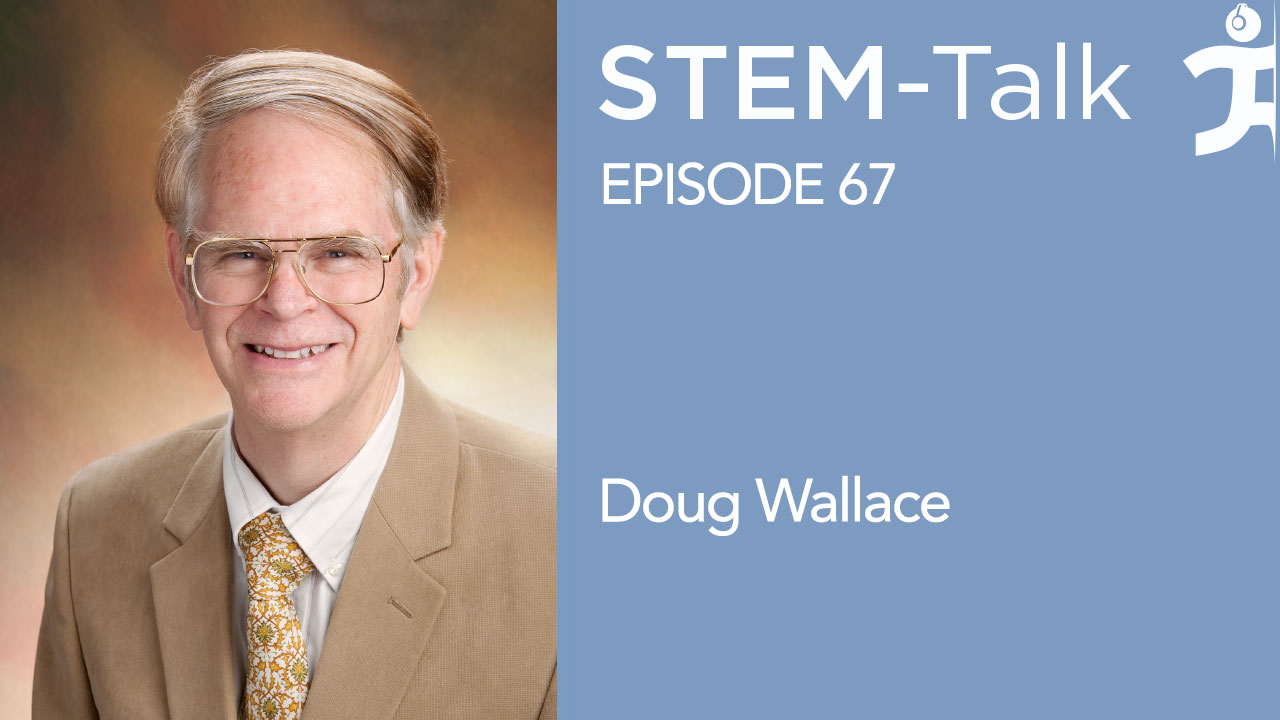STEM-Talk
Episode 67: Doug Wallace talks about mitochondria, our human origins and the possibility of mitochondria-targeted therapies
// Jul 3, 2018

Today’s guest is Dr. Douglas Wallace, the director of the Center for Mitochondrial and Epigenomic Medicine at Children’s Hospital of Philadelphia.
He is internationally known as the founder of mitochondrial genetics. Mitochondria are tiny structures within cells that produce 90 percent of a person’s energy and play an essential role in health and disease.
Dr. Wallace’s groundbreaking research in the 1970s defined the genetics of DNA within the mitochondria, as distinct from DNA in a cell’s nucleus. His research has shown that mitochondrial DNA is inherited exclusively from the mother and that genetic alterations in the mitochondrial DNA can result in a wide range of metabolic and degenerative diseases.
One of Dr. Wallace’s seminal contributions has been to use a mitochondrial DNA variation to reconstruct human origins and the ancient migrations of women. These studies revealed that humans arose in Africa approximately 200,000 years ago, and that women as well as men left Africa about 65,000 years ago to colonize Eurasia.
Dr. Wallace was inducted last year into the Italian Academy of Sciences during the academy’s 234th annual meeting in Rome. Founded in 1782, membership in the academy is limited to 40 Italian scientists and 25 foreign members. Over the years, the academy has seen such notable members as Albert Einstein, Benjamin Franklin, Louis Pasteur and Rita Levi-Montalcini.
Links:
Dr. Wallace’s Children’s Hospital of Philadelphia bio:
https://www.chop.edu/doctors/wallace-douglas-c
Mitochondrial DNA Variation in Human Radiation and Disease
Wallace Cell Perspective 9-26-15
Mitochondrial DNA Mutation Associated with Leber’s Hereditary Optic Neuropathy
Wallace LHON 11778 Science 1988
A Mitochondrial Bioenergetic Etiology of Disease
Wallace JCI Wallace JAMA Psychiatry2017
Association Between Mitochondrial DNA Haplogroup Variation and Autism Disorders
Maternal Inheritance of Human Mitochondrial DNA
Giles Maternal Inheritance 1980
Show notes:
3:32: Dawn opens the interview by mentioning that Doug grew up exploring the woods outside his neighborhood in the suburbs of Annapolis, Maryland. Dawn asks if his time outdoors sparked his interest in science when he was young.
4:14: Dawn asks Doug what led him to attend Cornell University after graduating from high school.
5:15: Doug talks about his decision to focus on genetics in school.
6:21: Dawn asks Doug how he selected Yale for his graduate studies.
7:49: Ken mentions that mitochondria can be considered bacterial “power-pack” organelles that generate the majority of a cell’s energy, as well as much else. He goes on to say that mitochondria account for about 30 percent of our bodyweight, and that there are roughly 500 trillion of them. He finally points out that despite all this that they are surprisingly under attended to and asks Doug to give listeners a brief mitochondria 101.
13:37: Ken mentions how he’s glad Doug answered the question of how mitochondria ended up losing 99 percent of their original genes, considering that mitochondria used to be free living bacteria with roughly 1,500 genes.
15:25: Dawn points out that Doug and his colleagues are credited with founding the field of human mitochondrial genetics more than 40 years ago. She then asks if anyone else was doing similar research when Doug started working on human mitochondrial genetics during his post-doc.
17:55: Following his post-doc at Yale, Doug spent seven years at Stanford University School of Medicine. Dawn asks Doug about his work during this time.
22:01: Dawn mentions that in 1983 Doug became the professor of biochemistry, anthropology and pediatrics at Emory University in Atlanta. During this time, he also was chairperson and senior editor of the Mitochondrial DNA Locus-Specific Database for the Human Genome Organization. Dawn asks what that work entailed.
24:11: Ken asks Doug about accepting a professorship of molecular genetics at the University of California, Irvine where he founded the Center for Molecular and Mitochondrial Medicine and Genetics.
26:25: Dawn mentions that in 2010 Doug moved to Philadelphia to become professor of pathology and laboratory medicine at the University of Pennsylvania. Going on to mention that he also became the founding director of the Center for Mitochondrial and Epigenomic Medicine at the Children’s Hospital of Philadelphia (CHOP). She asks what took Doug to CHOP what sort of work goes on at the center.
28:07: Dawn asks Doug to expand on the work he and his colleagues have done that shows that mitochondrial DNA is inherited exclusively from maternal linage, and that genetic alterations to mitochondrial DNA can result in a wide range of metabolic and degenerative diseases.
31:34: Ken brings up that Doug often talks about how Western medicine has generally approached most diseases from a primarily anatomical and Mendelian perspective, and how it seems that our bioenergetics inheritance has been largely ignored. He asks if this is beginning to change, given the recent attention Doug’s work has gained.
33:53: Ken discusses things from a systems perspective, saying that it stands to reason that as energy availability declinesone would expect to see organ specific symptoms of a systemic defect, asking for Doug to elaborateon this rather sensible perspective when viewed through the lens of energetics.
37:10: Dawn asks Doug to discuss his research into the mutation referred to as, “mtDNA ND6 P25L,” which results in elevated reactive oxygen species production and neurological disease.
45:21: Ken asks Doug to further discuss his work in using mitochondrial DNA variation to trace human migrations and origins.
49:03: Ken mentions how some of his friends submitting genetic material to “23 and Me” and seeing the haplogroups they have inherited from their mother has led to some confusion.
52:23: Dawn asks about the aspect of Doug’s research that suggests that there might have been an ancient European migration to the Americas, a conclusion extrapolated from studying a Native American Tribe in Central North America.
55:49: Dawn mentions the molecular clock, which is essentially the concept that mutations accumulate in a piece of DNA at a roughly constant rate because they occur by chance. She asks about the role of the molecular clock in mapping a population’s history?
58:05: Ken asks if Doug has looked at manipulating cells (when there are some cells with mitochondrial DNA mutations, and some without), to enhance autophagy and thereby get rid of the cells with the mutant mitochondria, and if so, would such interventions like intermittent fasting and the ketogenic diet have any benefit in patients.
1:01:23: Ken mentions that interventions such as intermittent fasting inhibit mTOR, asking if this inhibition is sufficient to have a substantial benefit.
1:03:36: Ken asks Doug to dive deeper into the phenomenon of how the high susceptibility of the mitochondrial DNA to mutations, alongside the fact that it is passed only along the maternal lineage, allows for the rapid adaptation to environmental stimuli while also eliminating the majority of detrimental mutations. Ken asks Doug to also talk about how these changes in mitochondrial genes enable animals to adapt swiftly to changing diets and climates.
1:07:18: Shifting gears, Ken asks for Doug’s thoughts on the possibility of life on other planets, and the bacterial basis for mitochondria on earth that allowed for the explosion of complex life on our planet.
1:09:30: Dawn asks Doug to expand on the concept of mitochondrial DNA variations permitting our migrating ancestors to adapt to new environments, and the idea that these adaptations can predispose certain individuals to disease in environments that their mitochondrial DNA isn’t adapted to.
1:12:21: Dawn mentions that Doug and his colleagues at the center are exploring how mitochondrial genes influence adaptation to extremes in our environment, such as artic cold, tropical heat and high altitude. Mentioning thatIHMC does a great deal of work on human performance in extreme conditions, Dawn asks Doug to talk his work in this area.
1:15:00: Ken asks — if it is even possible — if we should attempt to change how coupled we are, given that mitochondrial coupling can affect disease risk.
1:18:05: Dawn asks which haplogroups are at the highest risk for common diseases such as type 2 diabetes, Alzheimer’s, and cancer.
1:20:02: Dawn asks if people should be testing their haplogroups to see their susceptibility to certain diseases.
1:21:00: Dawn asks if Doug could talk a bit about his research into the association between mitochondrial DNA haplogroups and Autism Spectrum Disorder (ASD).
1:23:18: Dawn asks about Doug’s thoughts on the use of pro-nuclease transfer through three-person IVF, which is a very new and somewhat controversial technique designed to allow mothers with mitochondrial disease to have a baby without passing on that mitochondrial defect.
1:28:49: Ken discusses how mitochondria can no longer be viewed only through the lens of bioenergetics but also as platforms for intracellular signaling, regulators of innate immunity, and modulators of stem cell activity. Each of these properties provides clues as to how mitochondria might regulate aging and age-related diseases. Ken asks Doug to discuss how mitochondria participate in aging and whether a new era of mitochondrial-targeted therapies to potentially slow or reverse the aging process might be in prospect?
1:32:44: Dawn asks if there are any common environmental exposures that are negatively affecting mitochondrial function.
1:34:28: Ken asks Doug if, in addition to exercise, there are any other interventions that he thinks are broadly helpful in regards to improving mitochondrial function.
1:35:49: Dawn discusses how mitochondria produce local electromagnetic fields bymoving electrons as part of their normal function. She asks Doug if he has any thoughts on how external electromagnetic fields, such as those generated by electronics or communication devices, might interfere with mitochondrial function?
1:37:33: Ken mentions that Doug has hypothesized that the Qi and energy fields mentioned and targeted in Chinese medicine may actually be a proxy for mitochondrial phenotype and function. Asking how one might measure these in a human, and how could that affect disease treatment?
1:40:54: Dawn mentions how she is looking forward to seeing what comes out of the institute Doug is working on in China, which is bringing together Western, anatomical perspectives with the concepts found in Chinese Medicine.
1:41:09: Dawn comments on how Doug wasinducted into the Italian Academy of Sciences during the Academy’s 234th annual meeting in Rome. The Academy, founded in 1782, has a mission of encouraging scientific research. With a membership limited to 40 Italian scientists and 25 foreign members, the Academy’s long history, has seen such notable members as Albert Einstein, Benjamin Franklin, Louis Pasteur and Rita Levi-Montalcini. She closes the interview by mentioning how rewarding that must have been for Doug.






